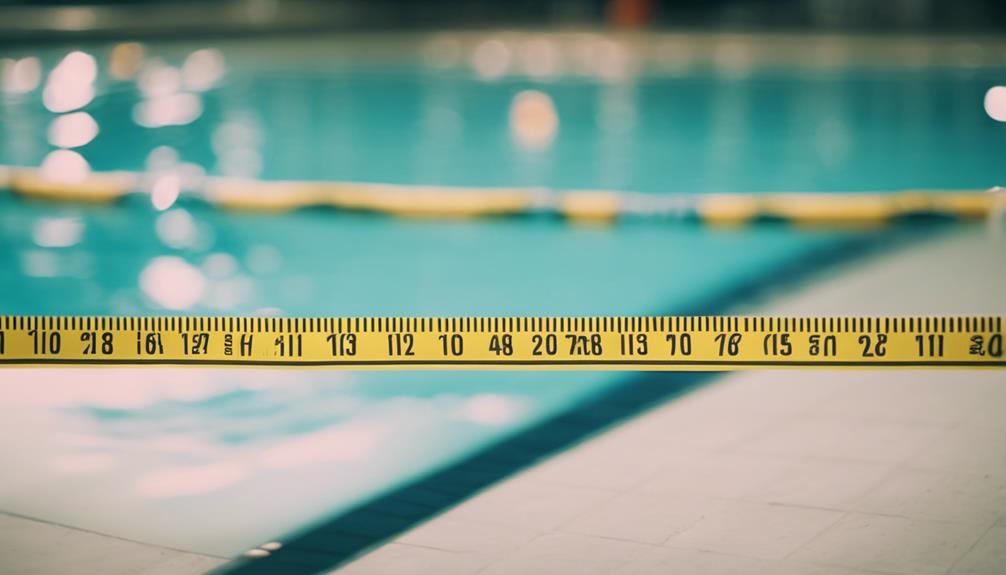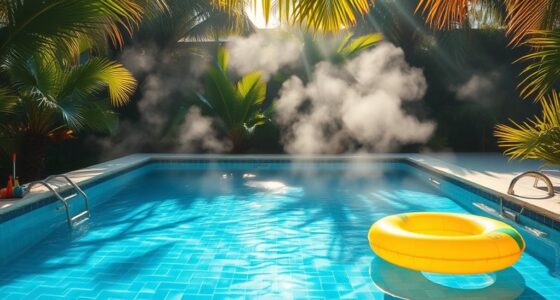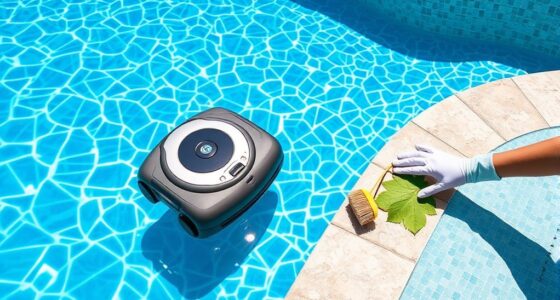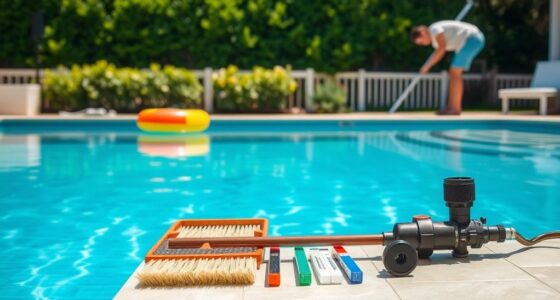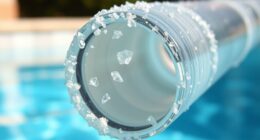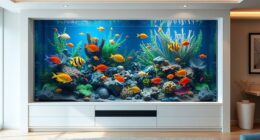To efficiently and cost-effectively heat your swimming pool, consider utilizing solar heating, heat pumps, and pool blankets. Solar heating utilizes collectors to capture the sun’s energy, resulting in long-term cost savings. Heat pumps draw warmth from the air, performing optimally during warmer periods. Look for high COP ratings and choose the correct size based on your pool’s surface area. Pool blankets help reduce heat loss and evaporation, while wind barriers can protect against heat loss and enhance overall efficiency. It is important to prioritize high-efficiency heaters that are correctly sized. Maintain water temperature between 78°F to 82°F and think about adding pool insulation. Different heating sources can impact efficiency, with electric heat pumps often being a preferred option.
Key Takeaways
- Choose electric heat pumps for efficiency and cost-effectiveness.
- Optimize pool insulation to reduce heat loss by up to 50%.
- Maintain water temperature between 78°F to 82°F for energy savings.
- Utilize pool covers to decrease heat loss and extend swimming season.
- Consider wind protection and pool blankets to enhance energy efficiency.
Solar Heating Benefits and Tips
For cost-effective and eco-friendly pool heating, consider harnessing the power of the sun with solar heating systems. Solar heating is an energy-efficient pool heating system that utilizes solar collectors to capture the sun's rays and warm your pool water.
While there are upfront costs involved in installing a solar heating system, the long-term savings on energy bills make it a significant investment. To maximize efficiency, it's important to position the solar collectors correctly in areas with ample sun exposure.
Solar panels come in different types: unglazed for above-freezing temperatures and glazed for year-round use, depending on your climate and pool usage.
Not only is solar heating environmentally friendly, but it also provides a sustainable solution for heating your swimming pool efficiently. By opting for solar heating, you not only save money in the long run but also reduce your carbon footprint, making it a win-win for both your wallet and the environment.
Optimal Heat Pump Usage

Consider running your heat pump during the warmest part of the day to maximize efficiency and save on energy costs. Timing plays an essential role in the energy efficiency of Heat Pump Pool Heaters, allowing you to make the most of their capabilities regardless of your location.
These pumps work by extracting heat from the air, making them both cost-effective and eco-friendly. To guarantee top performance and cost savings, opt for a heat pump with a high Coefficient of Performance (COP) rating.
Additionally, when selecting a heat pump, it's vital to take into account the sizing based on your pool surface area and temperature differentials. By choosing the right-sized pump, you can achieve the most efficient heating for your pool while minimizing energy consumption.
Pool Blankets for Efficiency
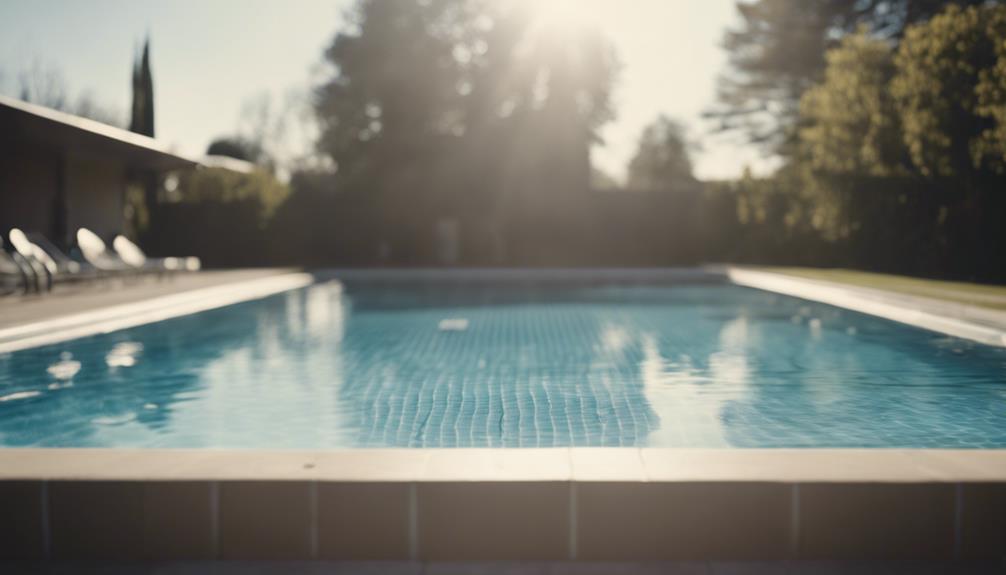
To enhance the efficiency of your pool heating system, pool blankets offer a practical solution for reducing heat loss and conserving energy. These blankets are designed to reduce evaporation by up to 95%, effectively minimizing water loss and preventing heat escape from your pool.
Opting for pool blankets with automatic deployment features adds convenience by providing easy protection for your pool when it's not in use. Bubble or floating blankets are particularly effective in retaining heat and preventing evaporation, helping to maintain the water temperature at a peak level.
Wind Protection Strategies
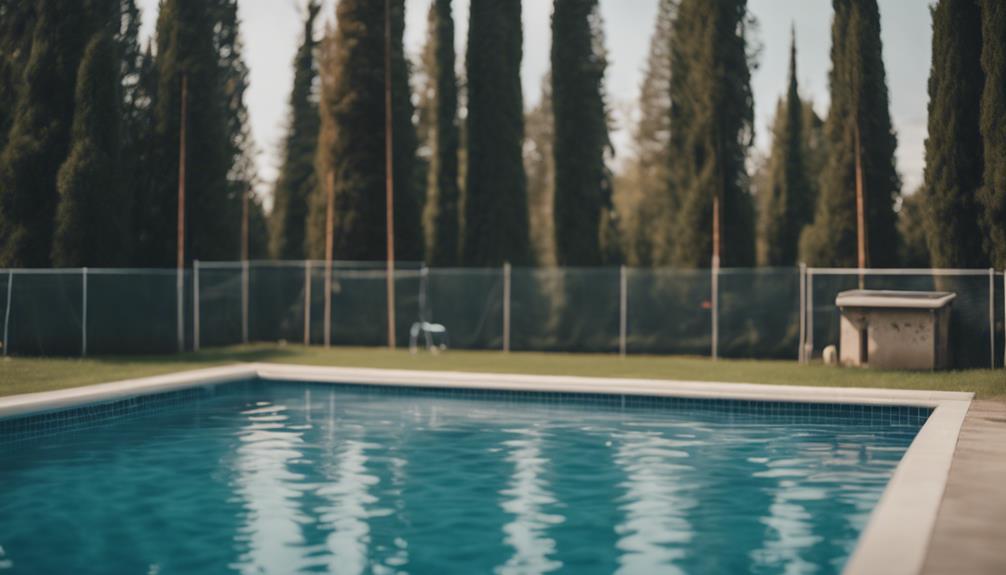
To protect your pool from wind and reduce heat loss, consider installing barriers like fencing or vegetation. These windbreak options can help lower your heating costs by preventing excessive evaporation.
Barrier for Wind
Installing windbreaks such as fencing and vegetation around your swimming pool can effectively shield it from heat loss caused by wind, ultimately saving you money on heating costs year-round. Windbreaks act as barriers that reduce the impact of wind on your pool, helping to maintain a warmer water temperature and decreasing evaporation rates. By implementing wind protection strategies, you can enhance the energy efficiency of your pool heating system, leading to lower overall heating costs and increased savings in the long run.
To visually demonstrate the impact of wind protection strategies, consider the following table:
| Wind Protection Measure | Benefits | Cost |
|---|---|---|
| Fencing | Blocks wind effectively, reduces heat loss | Moderate |
| Vegetation | Natural shield against wind, enhances aesthetics | Low |
| Windbreak Walls | Provides strong protection, long-lasting | High |
Windbreak Options
Wind protection strategies, such as fencing and vegetation, play an essential role in safeguarding your swimming pool from heat loss caused by wind.
By implementing windbreak options, you can effectively shield your pool from the cooling effects of strong winds, ultimately helping to maintain the pool temperature and reduce heat loss.
Not only do windbreaks contribute to energy efficiency by minimizing the need for additional heating, but they also offer a cost-effective solution for retaining heat in your pool water, especially in areas prone to windy conditions.
Investing in proper wind shielding is a key factor in optimizing the efficiency of your pool heating system year-round.
Whether through the installation of fencing or the strategic planting of wind-resistant vegetation, incorporating these wind protection strategies can make a significant difference in both the comfort of your swimming experience and the overall energy costs associated with pool maintenance.
High-Efficiency Heater Selection

When choosing a high-efficiency heater for your swimming pool, prioritize units with the highest COP ratings within your budget for maximum energy savings.
High-efficiency heat pump pool heaters (HPPH) are excellent choices for efficiently heating a pool.
Here are some key points to take into account:
- COP Range: Heat pump pool heaters typically have a COP range of 3.0 to 7.0, indicating their energy efficiency.
- Efficiency Measurement: The efficiency of these heaters is determined by their Coefficient of Performance (COP), with higher COP ratings signifying greater efficiency.
- Budget Consideration: It's important to select a unit with the highest COP rating that fits your budget to ensure top energy savings.
- Proper Sizing: Properly sizing the heater based on your pool's surface area and temperature differences is essential for maximizing efficiency and cost-effectiveness.
Temperature Adjustment Recommendations
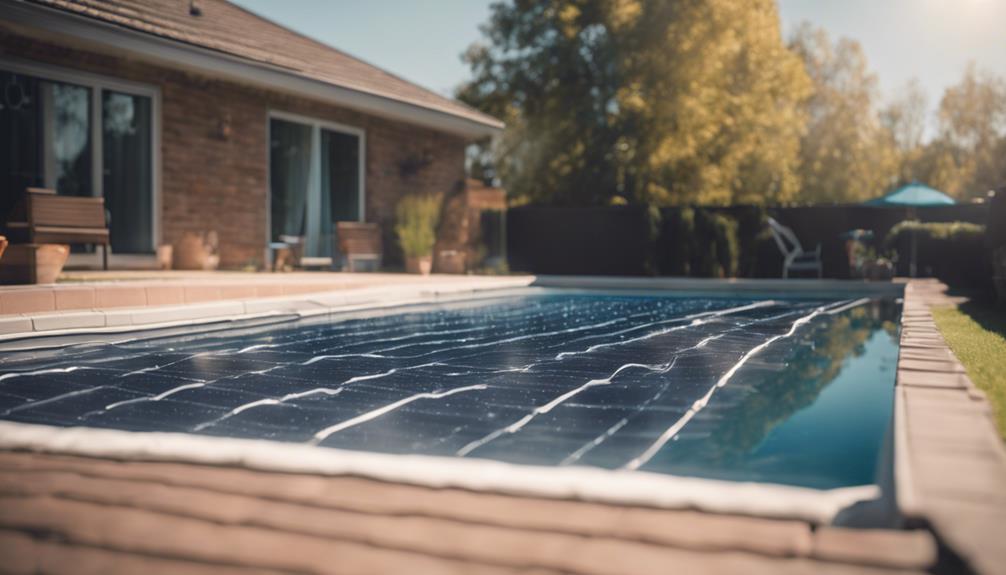
To optimize energy efficiency and comfort in your swimming pool, it's essential to adjust the water temperature within the recommended range of 78°F to 82°F. Keeping the temperature within this range not only guarantees a pleasant swimming experience but also helps in saving energy and reducing heating costs.
The American Red Cross suggests 78°F for competitive swimming, striking a balance between comfort and efficiency. Remember, every degree increase in pool water temperature can lead to a 10% to 30% rise in energy consumption, impacting your heating costs greatly.
One effective way to save energy is by turning off the pool heater when the pool isn't in use. Additionally, adjusting the temperature based on your pool usage patterns can help in further reducing energy consumption and cutting down on expenses.
Energy-Saving Pool Design Tips
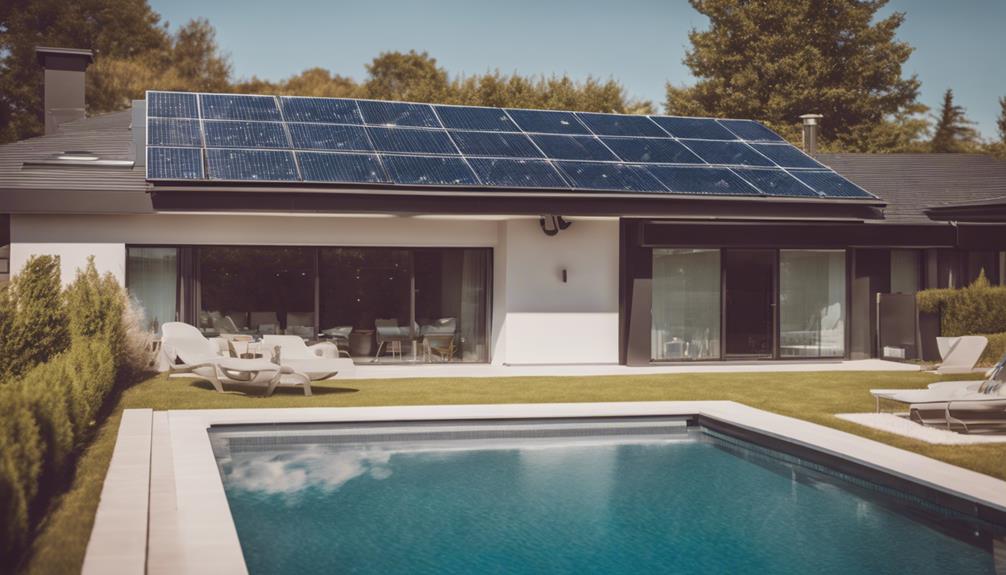
Consider implementing proper pool insulation to reduce heat loss by up to 50%, effectively cutting down on heating costs and improving energy efficiency.
When designing an energy-saving pool, optimizing mechanical systems is important to enhance energy efficiency and decrease operating expenses.
Additionally, the pool's location in the yard plays a significant role in maximizing heating efficiency and minimizing energy consumption.
To further save on costs, utilizing cost-effective pool heating sources like solar or heat pump systems is recommended.
Economical Heat Source Selection
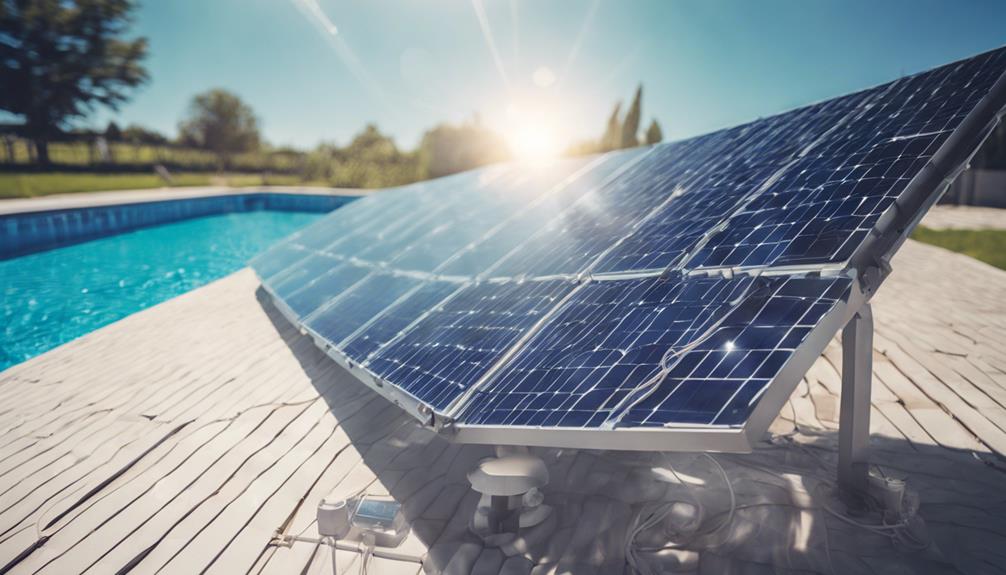
When selecting a heat source for your swimming pool, consider the efficiency and cost-effectiveness of each option.
Solar heating stands out as a top choice for its economical operation. Heat pumps also offer an efficient way to heat your pool.
Gas heaters provide quick heating but may lead to higher operational expenses over time.
Efficient Heat Sources
For the best efficiency and cost-effectiveness in heating your swimming pool, prioritize selecting an electric heat pump as your heat source. Electric heat pumps are highly efficient and cost-effective, making them ideal for maintaining a comfortable water temperature in your pool.
When considering different heat sources for your pool, keep in mind the following:
- Electric Heat Pumps: Efficient and economical choice for heating your pool.
- Gas Heaters: Outdated and inefficient, leading to higher operating costs.
- Solar Heaters: Sustainable option but can be complex and expensive to install.
- Water Temperature: Aim for 78°F to 82°F for peak energy efficiency.
Cost-Effective Options
To maintain cost-effectiveness in heating your swimming pool, prioritize selecting an electric heat pump as your heat source due to its efficiency and affordability. Electric heat pumps are a reliable option that draws heat from the air, making them energy-efficient for heating pools. Solar pool heaters, although sustainable, can be complex and costly compared to electric heat pumps. Gas heaters are outdated and inefficient, making them less favorable for cost-effective pool heating. Additionally, using pool covers can help retain heat and reduce the energy needed to heat the pool. Here is a comparison table to illustrate the cost-effectiveness of different heating options:
| Heating Option | Efficiency | Affordability |
|---|---|---|
| Electric Heat Pumps | High | Affordable |
| Solar Heaters | Moderate | Expensive |
| Gas Heaters | Low | Costly to operate |
| Pool Covers | Energy-saving | Cost-effective |
Efficient Heating Time Management
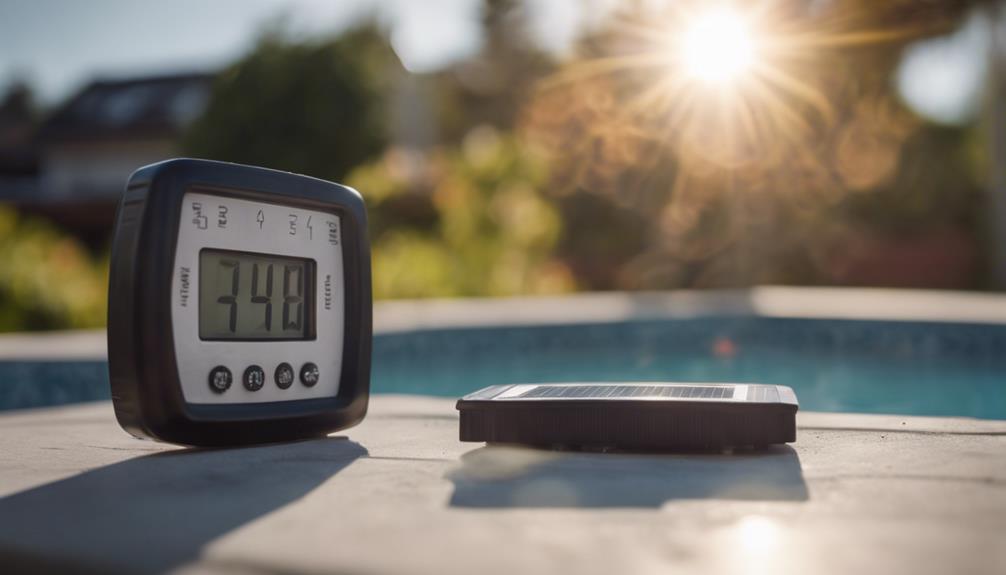
Optimizing the timing of your heat pump operation is key to efficiently managing the heating of your swimming pool. To make the most out of your heat pump and save on energy costs, consider the following strategies:
- Run the heat pump during peak sunlight hours:
This allows the heat pump to extract the maximum amount of heat from the air, boosting energy efficiency.
- Adjust the heating schedule:
Properly timing the operation of the heat pump guarantees your pool remains warm when needed without unnecessary energy consumption.
- Utilize the warmest part of the day:
Running the heat pump when temperatures are higher can enhance efficiency and lead to cost savings.
- Coordinate with sunlight exposure:
Aligning the heat pump operation with ideal sunlight exposure can result in significant reductions in pool heating expenses.
Evaporation Control Methods

To control evaporation and conserve energy, consider covering your pool surface with a pool blanket. These blankets can reduce water loss by up to 95%.
Windbreakers like fences or vegetation can shield your pool from heat loss caused by evaporation. This helps maintain water temperature efficiently.
Using these methods can not only save water but also lower your heating costs. This makes your pool more sustainable and cost-effective.
Covering Pool Surface
An effective way to control evaporation in your swimming pool is by covering the pool surface with a pool cover. Pool covers play an important role in maintaining the water temperature and reducing heating costs significantly.
Here are some key benefits of using pool covers:
- Reduced Heat Loss: Pool covers can decrease heat loss by up to 70%, helping to keep the water warm and comfortable for swimming.
- Minimized Water Evaporation: By using a pool cover, you can minimize water evaporation by up to 95%, saving water and reducing the need for frequent refills.
- Extended Swimming Season: Pool covers prevent debris from entering the pool, which not only keeps the water clean but also helps in extending the swimming season.
- Energy Efficient: Pool covers are an energy-efficient solution that can make heating your swimming pool more cost-effective in the long run.
Windbreakers and Fences
Utilizing windbreakers and fences can effectively reduce water evaporation from your swimming pool, providing increased heat retention and cost savings. Windbreaks, such as strategically placed fences and vegetation, act as barriers against wind, which is a significant factor in evaporation. By blocking the wind, these structures help retain the heat in your pool water, ensuring that it stays warm and comfortable for swimming. This, in turn, contributes to maintaining pool temperature stability and reducing the need for excessive heating, ultimately enhancing energy efficiency. By investing in windbreakers for your pool area, you can enjoy long-term benefits by minimizing heat loss and preserving the warmth of the water, especially in windy environments.
| Benefits of Windbreakers and Fences |
|---|
| – Reduce water evaporation |
| – Increase heat retention |
| – Save on heating costs |
Frequently Asked Questions
What Is the Most Cost-Effective Way to Heat a Swimming Pool?
For heating a swimming pool, the most cost-effective method is using an electric heat pump. It draws heat from the air, providing efficiency and lower operating costs. Solar heaters and pool covers are also beneficial for saving money.
What Type of Pool Heater Are Most Energy-Efficient?
For the most energy-efficient pool heating, go with electric heat pumps. They draw heat from the air, offering efficiency, cost savings, and comfort. Gas heaters are outdated, while solar options can be pricier and complex.
What Is the Cheapest Way to Run a Swimming Pool?
For running a swimming pool, the cheapest way is solar heating. It uses the sun's energy for electric heaters and pumps, leading to long-term savings. Remember, in regions with limited sun, positioning collectors correctly is key.
What Is the Cheapest Pool Heater to Run?
To heat a swimming pool affordably, consider solar heating for sunny areas, heat pumps for warmer climates, or gas heaters for quick heating. Solar systems save long-term costs, heat pumps use air, while gas is fast but may cost more.
Can Using Flocculant Affect the Cost Efficiency of Heating a Swimming Pool?
Using flocculant in pool water can actually affect the cost efficiency of heating a swimming pool. When flocculant is added to the pool water, it helps to remove small particles that can cause the water to be cloudy, and clear water absorbs more heat from the sun, making it easier to maintain the desired temperature.
Conclusion
To sum up, when it comes to heating your swimming pool, remember that saving energy doesn't have to break the bank.
By implementing cost-efficient strategies such as solar heating, heat pump usage, pool blankets, wind protection, and high-efficiency heaters, you can enjoy a warm and inviting pool without draining your wallet.
So, take a plunge into these energy-saving tips and make a splash with your pool heating savings!


